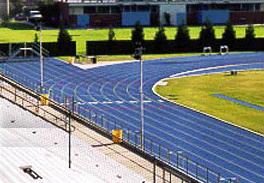Interview with Coach
Brian Bivens
(moving from Kennedy, La Palma
to Cerritos College)


July, 2006
Southern Section
Coach Answers few questions upon his move to Community College Level!
One of the fine track and field
programs, especially on the Girls sprint side in recent years in
the Southern
Section, was that
developed by Coach Brian Bivens at Kennedy HS in La Palma, with the North
Orange County power boosted by Janice Nsor (11.73), the Reid sisters,
Amanda Rosencrantz, Zahira Montanez, and Apryll White, among others,
to marks such as 46.57 (2005 400 Relay, among the top fifteen in the
entire
nation),
and
3:51.13
(among
top fifty in nation 2005). It has been fun to watch the program
develop, but things do change and Coach Bivens has decided to move up
to the next level, with the State Champion program at nearby Cerritos
College. We asked him a little about his background, the development
of the fine program at Kennedy, and wish him all the luck at the Commnity
College level in the future with the fine program at Cerritos (and new
facility "on-line.").
1) Where were you at during your prep career as a coach
and trace the positions you held?
1. I was a volunteer sprint coach
at Edison High School for a season in the mid 1990’s. Next, I was co-head coach for a season at Calvary
Chapel Costa Mesa training their cross country teams in I believe 1995.
We made CIF with our girl’s squad, finishing behind a tough Orange
Lutheran squad back when they were in the league. In 1999, I did my student
teaching at Fountain Valley High School and was asked to come out and
work with their sprinters. From 2000-2006, I was the head men’s
and women’s cross country/ track and field coach at Kennedy High
School.
2) What have you taught through the years - situations there - assume
you have been a full-time teacher in addition to coach?
2. I am a full-time, tenured teacher in the AUHSD. I teach general science
and health classes at Kennedy High School.
3) Who were your influences as a coach?
3. Early in my coaching career,
I worked in several physical therapy clinics and was strongly influenced
by
John Horsley at Restor Physical
Therapy. He taught me muscle balancing, stretching techniques, and allowed
me to work “hands on” with several track Olympians from Europe,
and a few pro basketball and baseball players. John Sayer, a former decathlon
competitor, helped me understand periodization and the management of
a multifaceted training program, including power lifting. Mark Roche
out of Coast Physical Therapy introduced me to plyometric training and
its application in the pro beach volleyball scene. At Long Beach City
College, I was greatly influenced by Coach Richardson, Coach Washington,
Coach Elias, and of course Ron Allice. I followed Ron Allice to USC,
where I continued to train and watch his system develop. Coach Goldman
and Coach Wells at Cerritos College have most recently helped me refine
the art of coaching track and cross country, thus the move to JC track.
4) Kennedy seemed to have a good mix of different types of kids, talk
a tad about the community and school--
4. Kennedy does have a great mix of cultures. That is certainly one
of its strengths. The school itself has a very strong band and choir
program, as well as strong AP and IB academic programs. It is often the
case at the school for kids to be involved in a sport, ASB, choir or
band, all at the same time.
5) What kind of a year round program were you able to run with track
and field at Kennedy?
5. La Palma does not have any kind of youth track or running club, so
it was very difficult to keep kids running outside the season of sport.
Athletes are encouraged to play a variety of sports at Kennedy. This,
combined with the regular 6th period track class, were the primary tools
to keep the kids in shape.
6) Why did the program, especially girls sprint segment, take off just
a few years back at Kennedy - culmination of what or special group of
athletes?
6. It was easier for me at first to get the girls on campus to come
out and run because they were really not involved with any other sports.
I walked around school and tried to sell the track program to them. Most
of my female sprinters were outstanding students who in the beginning,
ran for fitness. The primary reason that the sprinters developed first,
was that I ran a highly successful system that I learned at Long Beach
and USC. Also, lets face it. Distance runners take longer to develop
than sprinters. The entire physiology and training philosophy is different
between the two groups.
7) What are your thoughts on moving up to the next level at the Community
College, with Cerrritos the 2006 State Track and Field Women's Champions.
7. I am excited to be joining the Cerritos College staff. I look forward
to being able to work with a larger sample of the running community in
Southern California. We have a new multimillion dollar track being completed
as we speak, and I believe Cerritos College will continue to host new
and exciting high school and college events. I hope to be apart of more
State Championships at the JC level, and to contribute to the development
of track and field in the USA.